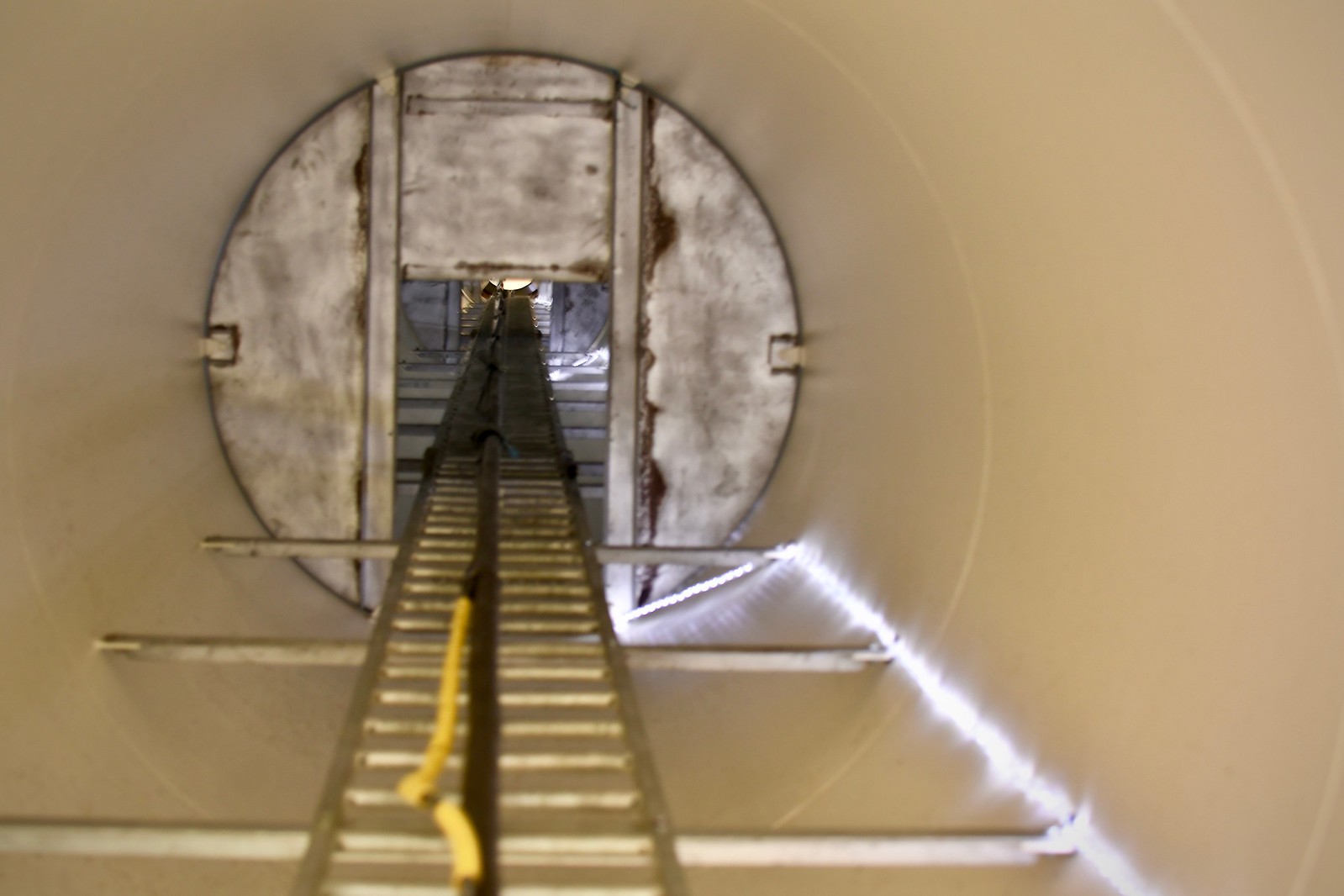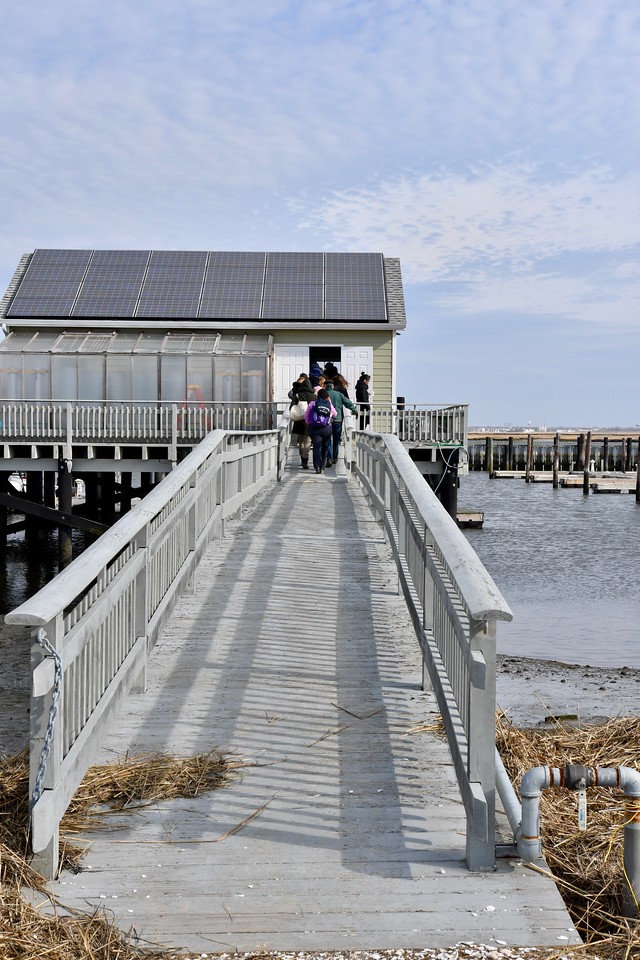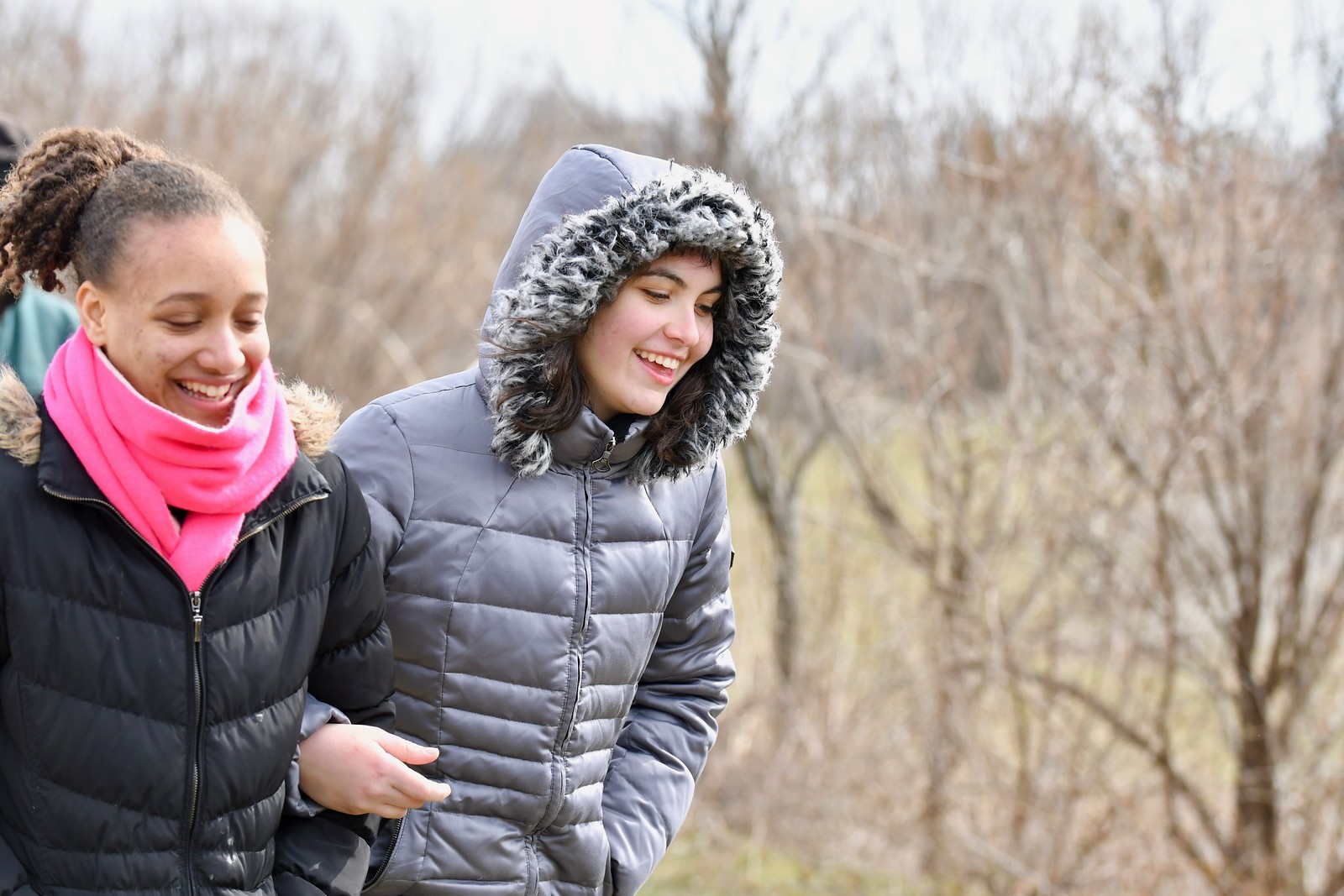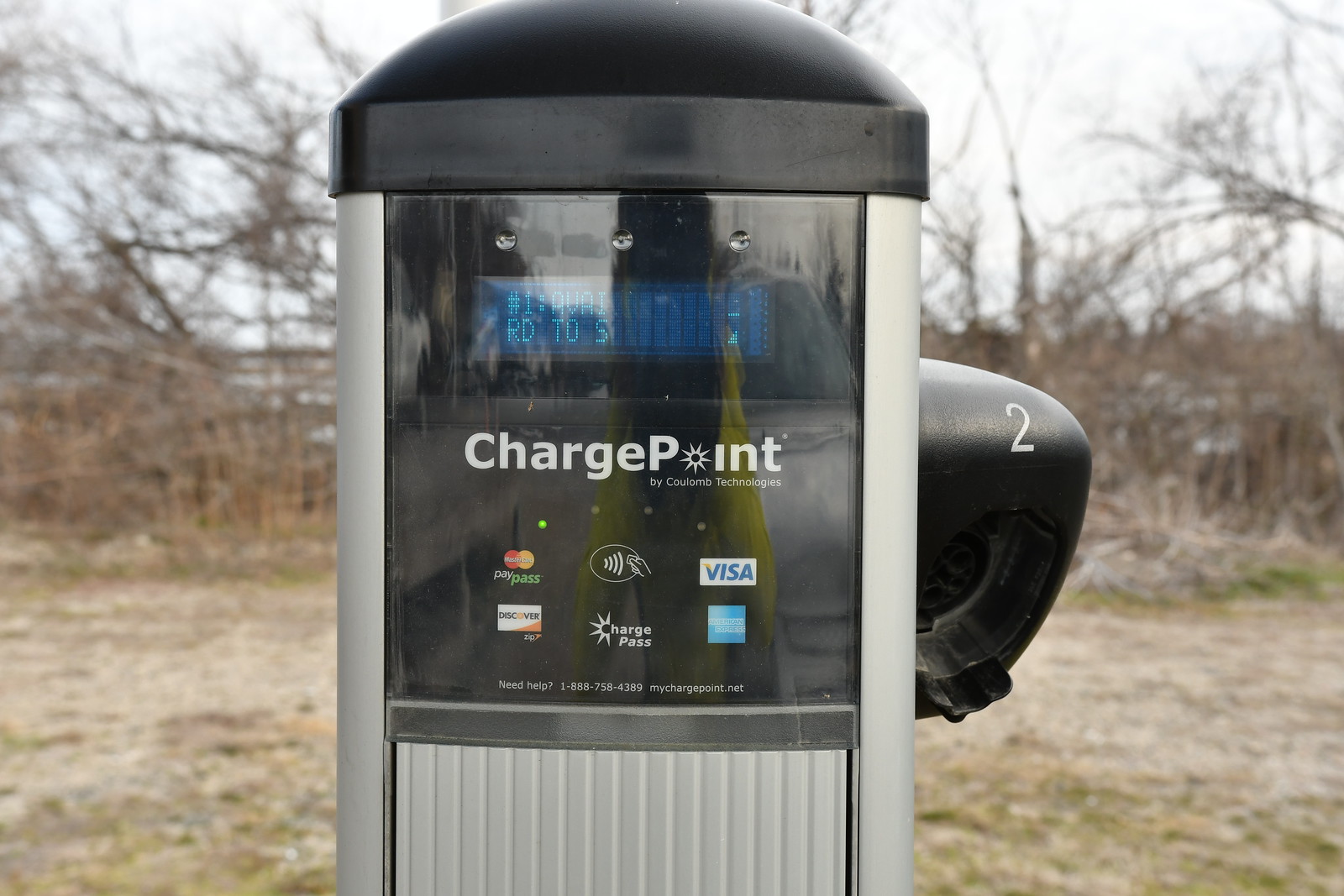Each Friday, students have the opportunity to work in a living laboratory where they see real world applications of the various concepts taught in the classroom. Below you can read a synopsis of their trips.
March 24, 2017: Hempstead Energy Park
The Town of Hempstead Energy Park is a pioneering entity that meets the heating and cooling needs of a municipal facility on Long Island while serving as a model for other local governments across the United States. Nestled within Point Lookout, the energy park has a majestic 100-kilowatt wind turbine with a hydrogen fueling station, a solar house, a pair of solar trackers (high-tech solar electric panels that follow the sun’s daily path across the sky), a 60-kW solar field, a solar-powered carport and a geothermal energy project.
Last Friday, we were given a behind the scenes tour of the facility by one of the Town of Hempstead’s staff biologists. This included going inside of the 120-foot tall (excluding the 35-foot blades) wind turbine, which powers a hydrogen fueling station. The wind turbine provides electricity to power a water-to-hydrogen conversion process, which produces hydrogen fuel. Just a short distance away was a self-reliant solar house designed by architecture, engineering and interior design students at New York Institute of Technology for the U.S. Department of Energy Solar Decathlon in 2007.
We then took a short walk to a solar and wind-powered shellfish aquaculture facility designed to improve the ecosystem in Hempstead Bay and protect the business of local fisheries by using alternative energy to increase shellfish production. I felt a connection to what we had learned in the Waterfront Center earlier in the year as we discussed the dwindling natural population of shellfish around Long Island and how contaminants after significant downpours trigger the closure of shellfish harvesting. We once again were reminded how runoff from pesticides and other pollutants can affect our local wildlife. Water testing usually begins the day after a storm; when test results show that water samples have returned to baseline levels, closures are lifted.
We closed our trip with a hike in the Lido Beach Passive Nature Area —40 acres of an ecologically sensitive property of tidal wetlands. The area supports a wide variety of grasses, vegetation and marine life, including several species of fish and shellfish. The conservation area is also part of the Atlantic Flyway. You may recall that several of us were disappointed that we had not spied an osprey at the Marine Nature Study Area in Oceanside. On Friday, we were rewarded with a beautiful view of newly arrived osprey taking up residence in their home.
March 17, 2017: Marine Nature Study Center
Our third visit to the Marine Nature Study Center was split between an indoor activity, which introduced students to a compound light microscope; and an outdoor walk of the property to look for the early migrants that have arrived.
Indoor Study
Students received a general overview of a compound light microscope, and created their own unique slide. Additionally, they worked with ten prepared slides of various plants, insects and/or animal tissue. Finally, they illustrated and wrote about their personal observations in this introductory lab.
Outdoor Study
Even on a cold and blustery day, the Nature Center offered an opportunity to immerse oneself in a remarkable natural setting. Friday was the first day an osprey sighting was possible, though several of us were fooled by a crow that had landed in the nest atop the pole where these majestic creatures live. Conservation Biologist Michael Farina pointed out several birds along our trek. He also shared with us that the late-winter snowstorm, coupled with the unseasonably warm weather weeks earlier, caused masses of the birds to break from their migration pattern, in some cases with dire consequences. Migration can be triggered by a combination of changes in day length, variations in temperatures, changes in food supplies, and genetic predisposition.
February 3, 2017: Cold Spring Harbor Laboratory-DNA Learning Center West-DNA Restriction Analysis
Eighth grade students participated in an experiment which demonstrated that DNA can be precisely manipulated and that it behaves as predicted by the Watson-Crick structure. Students used restriction enzymes, the scissors of molecular biologists, to cut DNA from the bacteriophage lambda. The resulting DNA fragments were analyzed by agarose gel electrophoresis. Our lab field trip at the DNA Learning Center West location also included a tour of the adjacent Clinical Core Laboratory, home to one of the largest robotic machines involved in diagnostics.
January 27, 2017: Cradle of Aviation Museum
Wind power is one of the fastest growing energy sources in the world, and students ended the four weeks of study at the Cradle of Aviation Museum with an opportunity to experience wind power firsthand. After an introductory lesson on energy, eighth graders were broken into teams to engineer a working wind turbine. This exploratory project engaged the students in engineering and demonstrated concepts such as energy transformation and blade efficiencies. Students used PVC fittings to build the base of their creations, sheets of balsa were manipulated for the blades, dowels and crimping hole hubs held the blades together, and a DC motor was fed into a PVC coupler. We went to the Museum’s Wall of Wind to test the various prototypes and attached a multimeter to measure the voltage. It was great fun to see which team’s model worked most efficiently and to hear about the thinking behind their unique designs.
January 13, 2017: Cradle of Aviation Museum
From ballooning to the Moon…an evolution of aviation, all in under an hour. Students went on a museum educator-led program that took them through the museum’s collections focusing upon major events and aircraft in aviation history. For the second hour, they were able to get up close and personal with several aircraft as they engaged in an activity where they calculated the area and aspect ratio of wings. The aspect ratio of a wing is the ratio of its span to its mean chord. Students learned that the aspect ratio and other features of the platform are often used to predict the aerodynamic efficiency of a wing.
January 6, 2017: Cradle of Aviation Museum
Air pollution not only degrades the environment but also causes significant health problems for the human population. The Environmental Protection Agency (EPA) monitors the six criteria pollutants– particulate matter, carbon monoxide, ground-level ozone, sulfur dioxide, nitrous oxides, and VOC’s. Students participated in an exercise where they audited their lifestyle over a period of 24 hours and used food dye and water to simulate their impact on air quality. At the end of the demonstration, their cups of colored water provide a striking visual reminder of students’ contribution to air pollution.
December 16, 2017
Adelphi’s Environmental Studies program, in conjunction with the Environmental Action Coalition, the Environmental Honors Society and Green Living-Learning Community screened the new documentary film “Before the Flood” on campus and our 8th grade students had a private screening. Before the Flood, presented by National Geographic, featured Leonardo DiCaprio on a journey as UN Messenger of Peace, traveling to five continents and the Artic to capture climate change firsthand
December 9, 2016: Marine Nature Study Area in Oceanside
On a cold and sunny morning, we returned to the Marine Nature Study Area in Oceanside. Students were asked to stand no closer than 25 feet to a classmate as they spread out across the 52 acres of the nature preserve for 15 minutes of silent contemplation. Alone with their thoughts, they were to think and wonder at the meaning of what they were seeing. Upon gathering back in the warm classroom at the Nature Center, the students shared their observations, where they noted with delight, the small and inconspicuous.
On a day like today, I am reminded that some of nature’s most exquisite expression can be missed when observed too hastily. And that senses other than sight can prove avenues of discovery—the marvelous evocation of odors with the rising and falling of tides exposing mud flats or the pleasure of cultivating our hearing to be attune to the passing loon. The rest of our time was spent completing scientific illustrations representing different flora and fauna of the salt marsh. We look forward to returning to Nature Center in the spring!
December 2, 2016: Oceanside Marine Nature Study Area
Beddell Creek forms the eastern border of the Oceanside Marine Nature Study Area, a 52-acre preserve owned by the Town of Hempstead within the 325-square-mile Long Island South Shore Estuary Reserve. Today we met with Michael Farina, a Conservation Biologist at the Marine Nature Study Area who gave us a tour. In order not to destroy marshes, elevated board walkways have been constructed to provide access from the “Salt Marsh Ecosystem Site” to the “Marine Algae Site” and to the “Dune Community”.
During his presentation on the Ecology of the Salt Marsh, he discussed that the salt marsh is a dynamic system. We covered topics, which included coastal tides, salt marsh zones, challenges to existence in the salt marsh and environmental problems. Along the way we were able to see many different birds and other living organisms. Finally, we conducted our last water sampling of the 2016 year! We hope to return in the spring, to see how the variety of species changes in the warmer weather.
November 18, 2016: Old Westbury Gardens
Today, the 8th grade returned to Old Westbury Gardens for a two-part lesson.
History: The first part of the morning was spent reviewing second hand print articles about the Phipps family from the turn of the last century. Students were then asked to engage in projects that utilized the media channels used today to get similar stories out to the public. Finally, students were divided into three groups, and using the areas of industry the Phipps family was well known for (steel, shipping and fashion), they were asked to construct a campaign using the media outlet of their choice to launch a business campaign around one of those three areas.
Science: The second half of our time was spent examining the underground world of soils. Discussions highlighted soil composition and formation.Two hands-on digs provided students with an opportunity to take a closer look at the soil texture of different areas of the Gardens and the life that lies within the earth, while completing soil testing.
November 15, 2016: Special Adelphi Fieldwork Class
As a part of the Friday fieldwork program, during the 8th grade Science class today, the students had the opportunity to visit Adelphi University. Adelphi is a leader in the field of energy conservation and recycling. Students met with several staff members: Kathleen “Green Machine” Watchorn, Coordinator of Special Projects and Programs, Lisa Marino, from the Green Living-Learning Community and Kerry Nicollet, Manager of Project Management, IT. We had a chance to learn about the green initiatives on campus, how Adelphi’s new construction is LEED certified, and what that type of designation means.
Next week, Assistant Vice President for Facilities, Bob Shipley will host us on campus again, where we hope to delve deeper into some of the green concepts discussed today and visit the newest construction on campus!
November 4, 2016: Heifer Institute (Special 7/8 Grade Joint Experience)
Having just spent three days with the seventh and eighth grade boys at Heifer International’s Global Gateway Village, I am struck by how quickly our perspectives on life can shift.
Like many of you, I knew Heifer’s work from the catalogs they send out at holiday time. Their visually stunning photography is combined with text that states that for a fee you can purchase livestock that will go to an individual living in an impoverished area of the world.
When I read about the Heifer’s Global Gateway Village and its immersive approach to teaching students about poverty I was intrigued. I am a big believer in not being constrained by the bricks and mortars of a school building to further education. So, the opportunity to recreate the living conditions of various countries and be able to have students step into that world seemed like a great way to develop empathy.
Our journey began on Monday, with the students being asked to reflect on their own identities, their communities, and the things that they valued. Over time, the emphasis shifted to learning about places and cultures they were less familiar with. Alongside, students participated in meaningful work on the farm–tending to the many variety of livestock being raised there, which were indicative of the livestock found with the regions Heifer works with.
And then we hit lunch on day two–A sobering affair of working in groups to prepare an open fire and create a simple Peruvian meal with the ingredients native to the area. We began to see the distinctions in how people eat, from the scarcity of resources to the time that it takes to prepare a meal without modern conventions. Another transformation was happening alongside this path of enlightenment–this disparate group of students was forming a community. When there wasn’t enough stew to fill everyone’s bowl, each student donated some of theirs, to those in need. When the people tending the fire needed kindling, different students went out to forage for wood to support the whole group. This strengthening of community continued into the night as the students spent their evening in the Global Village, in simple structures, without electricity, in each others’ company.
In fact, sleeping in family groups of one sort or another has been the norm throughout human history and is still commonplace in most of the world. You eat together, sleep together, laugh together, suffer together. I thought about those ideas against the backdrop of a typical American lifestyle, where many families are isolated from wider communities and personal gain almost completely eclipses collective good. I began to think that whatever the technological advances of modern society the individual lifestyles that those technologies spawn may be deeply brutalizing to the human spirit.
In the end, I acknowledged that a short taste of the Heifer experience can, yes, help us feel compassion for those who live without the luxuries we have, but it also helped us get a glimpse at the benefits of living in tightly held communities where cooperation is the only way to survive.
The girls arrived at the Heifer Institute yesterday and we took a pastoral stroll around the Heifer property. When it started to rain, a fellow hiking family offered our group shelter from the weather while Paul, the Educational Director at Heifer, picked up some of our slower hikers to keep us dry. We were overwhelmed with the care and concern we received from these new friends and very much appreciated from their hospitality.
Today, after preparing lunches in Guatemala & Peru huts, named after the countries in which each style of hut was constructed, we will be divided into three groups and will spend the nights in Appalachia, Tibet, and Poland.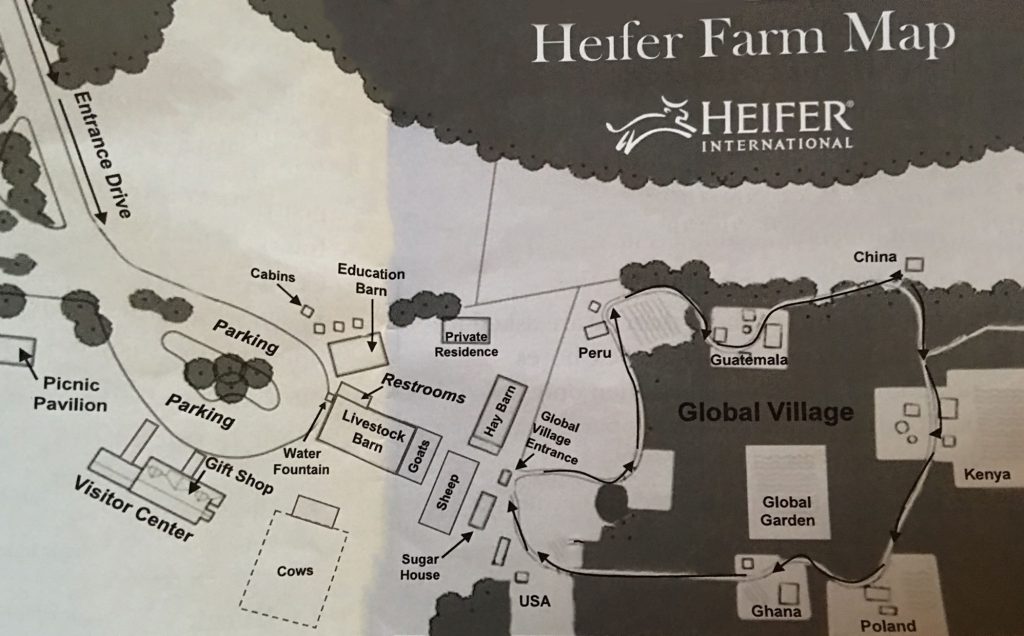
This morning began with animal chores. We formed a human tunnel as we guided sheep and goats to pasture. This is a truly joyful activity that brought a smile to all.
We hope you enjoy these few photos. We will have more to share next week.
October 28, 2016: Billion Oyster Project
Today we launched our Restoration Station and officially became part of the Billion Oyster Project (BOP), a region-wide restoration and education initiative for schools and community groups. This program provides a citizen science platform and a hands-on curriculum to engage students in marine science, restoration, and stewardship at the water’s edge. The main goals of the program are to help rebuild native oyster populations by installing small, protected breeding colonies of “spat-on-shell” oysters in strategic locations and to engage students, in environmental monitoring, science, and stewardship around their local marine environment and waterfront.
What is a “Restoration Station”?
Our multi-parameter monitoring platform allows for a wide range of data collection through the following components:
- A Standard Oyster Cage, which contains 70 oysters of which 10 substrate shells are tagged and all oysters on those shells are measured.
- A Middle Unit, which is a mobile organism trap, divided into two sub-areas, each of which contains a different substrate: cured shell and plastic mesh.
- A Lower Unit, which is a triangular sessile trap with ceramic tiles, oriented in different ways to the water column.
- A Sediment tube, which is a Graduated PVC pipe, to collect sediment for measurement and analysis.
We used specific BOP protocol to measure, tag our oysters, and complete water and other testing. Our Restoration Station was attached to a dock in Oyster Bay in conjunction with the Waterfront Center. We will be monitoring it and recording data with regular visits. This data will be shared with various organizations and scientists involved with the Billion Oyster Project.
October 21, 2016: Science Museum of Long Island
Today’s rainy weather did not keep us from participating in our Friday fieldwork program! We visited the Science Museum of Long Island, where we took advantage of their 40-acre nature preserve, called Leeds Pond Preserve. The Preserve allowed us to hike and explore natural environments such as a dense forest, a lush marsh, a meandering stream, a brackish pond, and beachfront on Manhasset Bay. We continued learning and practicing the techniques of biological sampling as well as testing the physical and chemical parameters of the various bodies of water on the property.
October 7, 2016: Bacterial Transformation Lab – Glowing Genes Activity
On Friday, October 7th, the eighth grade visited Cold Spring Harbor Laboratories, where students conducted a bacterial transformation–a type of genetic engineering. By using a plasmid vector, students inserted two new genes into harmless E. coli bacteria. The first gene coded for Green Fluorescent Protein (GFP) and is found in the Pacific Jellyfish. The second gene allowed the bacteria cells to produce an enzyme which made them resistant to the antibiotic ampicillin. After successfully transferring a plasmid into the host cells, the E. coli exhibited the signs of two new trait. Not only did the bacteria have the ability to survive in ampicillin, it also glowed green!
September 3o, 2016: The Biology of Plankton & The Ida May Project at The Waterfront Center
For today’s field experience, students explored the importance of plankton with hands-on collecting and classifying. Students utilized scientific equipment to collect and observe specimens and discussed the symbiotic relationship between plankton and water quality.
As our eighth graders continue their study of American History during their Main Lesson classes, they will come to realize that from the earliest settlers who farmed shellfish and built dugout canoes, to residents and visitors who enjoy the world-class boating today, Long Island’s story is inextricably linked with the sea. Building off Oyster Bay’s history of shipbuilding, today we traveled to the former Jacobson Shipyard and oyster farm. There we were inspired by the energy, expertise and passion of volunteers who are building a replica of the “IDA MAY”, which harvested oysters in Oyster Bays for over 75 years. The “IDA MAY” represents the transition from sail-powered oyster sloops like the historic Christeen (from last week’s trip) to modern harvesting vessels.
September 23, 2016: Sailing Into Science
Eighth grade students boarded the Christeen. The historic 1883 oyster sloop is a national historic landmark. For three hours this became their floating classroom. After hoisting sails on this beautiful day, students gathered information about the local ecosystem by conducting water quality research and participating in a plankton tow. While working in cooperative learning groups students examined, recorded and compared water quality, geology and the biodiversity around the Long Island sound.Click here for photos!
September 16, 2016: Crab Study
Today, the 8th grade participated in a special crab study. Their goal was to learn about invasive species and how they are impacting the local and global environment. Students sorted crabs, identified trends and anomalies in currents, and took beach water samples in search of useful scientific data.
September 9, 2016: Estuarine Exploration
Today, the eighth grade began its field work with a trip to the Waterfront Center in Oyster Bay. There, students performed an in-depth study of an estuarine ecosystem. Working in cooperative learning groups, students rotated through different stations and locations while examining, recording and comparing the water quality, geology and biodiversity of each site using techniques and equipment used for research and environmental assessment. We were very happy to see students engaging with the natural world and conducting scientific research.

